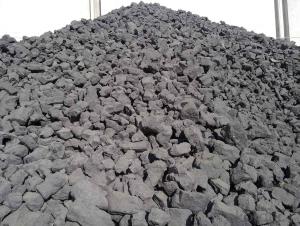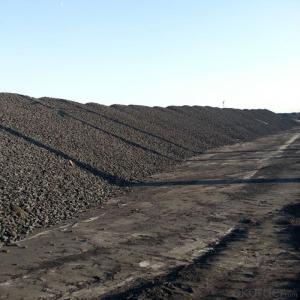the NUT Coke of Low Phos (0.018%)
- Loading Port:
- Tianjin
- Payment Terms:
- TT OR LC
- Min Order Qty:
- 100 m.t.
- Supply Capability:
- 3000 m.t./month
OKorder Service Pledge
OKorder Financial Service
You Might Also Like
1. Structure of the NUT Coke of Low Phos (0.018%) Description:
Coke is made by high temperature metallurgical coke for blast furnace smelting, casting and gasification. Occurring in the process of coking after recovery and purification of coke oven gas is a high calorific value of fuel, is an important industrial raw material in organic synthesis.
Coke is mainly used for blast furnace ironmaking and used for copper, lead, zinc, titanium, antimony, mercury and other non-ferrous metal smelting of blast furnace, reducing agent, compound and the function of stock column frame.
Blast furnace with Coke instead of charcoal, which laid a foundation for the large-scale of modern blast furnace, is a major milestone in the history of metallurgy.
On China's coke production distribution, the regional distribution imbalance of coking enterprises, mainly distributed in north China, east China and northeast China.
2. Main Features of the NUT Coke of Low Phos (0.018%):
• Quality assurance
• Mutual benefit
• Preferential price
• Various choice
3. the NUT Coke of Low Phos (0.018%) Images:




4.the NUT Coke of Low Phos (0.018%)Specification:
Quality | Quality guaranteed | Rejection limits |
Moisture (ARB) | 7% max | --- |
Ash (DB) | 12.5% max | >13.5% |
Volatile Matter (DB) | 1.5% max | >1.8% |
Sulphur (DB) | 0.65% max | >0.75% |
Phosphorus (DB) | 0.018%max | >0.025% |
Size 10—30mm | 90%min | |
-10mm | 5%max | >8% |
+30 | 5%max | >8% |
5. FAQ
We have organized several common questions for our clients,may help you sincerely:
1) How to guarantee the quality of the products?
We have established the international advanced quality management system,every link from raw material to final product we have strict quality test;We resolutely put an end to unqualified products flowing into the market. At the same time, we will provide necessary follow-up service assurance.
2) What are coke's main physical properties?
on the relative density of density, coke, coke porosity, thermal conductivity for the heat capacity of coke, coke, coke, coke ignition temperature, coke thermal expansion coefficient of thermal stress and coke, coke shrinkage rate, coke resistivity permeability, etc.
The average heat capacity is 0.808 kj/(KGK) (100 ℃), 1.465 kj/(KGK) (1000 ℃)
Thermal conductivity is 2.64 kj/(MHK) (room temperature), 6.91 kj/(MHK) (900 ℃);
Ignition temperature (air) is 450-650 ℃.
3) How about your company?
Our company began to export coke when China cancelled 40% of coke export tariffs and quotas on January 1, 2013. We export many kinds of coke, such as CSR60 % and CSR 62% metallurgical coke (met coke), the NUT coke of 20 to 50 mm, coke breeze of 3 to 6 mm, and so on.
- Q: Types of coke and use of coke
- Generally speaking, the use of coke in the following industries: blast furnace ironmaking, mechanical casting, calcium carbide production, processing Ferroalloy, chemical fertilizer, gas and high-tech high value-added industries
- Q: Coke is divided into several kinds of specifications ah
- (Lord Jiao Meilian) {for precision casting and ductile casting for} fixed carbon above 86; sulfur ash is below 0.5; 12; 1.5: volatile fiddle coke grain size 4cm--8cm or above 10cm: fixed carbon furnace for {}} setting common casting coke particle size 25cm:{for precision casting and ductile casting for 3 more than 88 tons of sulfur ash; 0.5; 10; 1.5: volatile foundry coke particle size 25cm:{type applicable to the above all high precision ductile casting export and international index: {8cm} fiddle coke for common casting and casting products such as strict fire pump fittings; fasteners such as high fixed carbon above 788385} sulfur: {for copper, aluminum, plastic, chemical coke} fixed carbon above 83 gas coal coke: {for carbon monoxide gas extraction, rich gas} fixed carbon about 78 coal coke: {casting parts annealing, Coke, coke, civilian chemical copper, aluminum, plastic} fixed carbon about 65 coke, coke coal: {civil casting parts of annealing, chemical coke}
- Q: Why does Coke provide heat when it is fired, it reacts only at high temperatures and why it is needed to provide heat?Which is the exothermic reaction, carbon dioxide or carbon monoxide?
- In addition to the reaction of iron and iron oxide will react C+O2=CO2; reaction exothermic;
- Q: How to distinguish the level of coke. What is metallurgical coke
- Coke type: coke is usually divided by use of metallurgical coke (including blast furnace coke, coke and iron alloy coke etc.), coke and calcium carbide with coke gasification
- Q: Can the sulfur content of coke affect the casting process of nodular cast iron at 0.65?
- The high sulfur content of nodular cast iron, the most significant impact on the casting is caused by poor balling,
- Q: The sulfur content of coal and coke in general, the coking process of sulfur content of coal into the output of sulfur content of coke compared to those who are high and low?
- The sulfur content of coking coal basically all into the coke, only a small number into the gas but the number is very limited. How much coal is the amount of sulfur in the general coal is the sulfur. It should be said that coke is basically a little lower and a little bit limited.In the process of coking volatile will be a lot of consumption, ash will increase 2-3%.
- Q: I work in the coking plant, so there are conditions to get coke and is burning, I would like to use coke barbecue line? Just like charcoal Mutton Cubes Roasted on a Skewer, OK? Understand the answer
- I work in the coking plant, so there are conditions to get coke and is burning, I would like to use coke barbecue line? Just like charcoal Mutton Cubes Roasted on a Skewer, OK? Understand the answer
- Q: How long should it be to store coke in the open air
- And the most important thing is to avoid the sun. Coal and coke, like the sun, the temperature inside the stack is very high. So try to cool down.
- Q: What is coke and how is coke classified?
- Types of cokeCoke is usually divided by use of metallurgical coke (including blast furnace coke, coke and iron alloy coke, calcium carbide and coke gasification etc.) with coke. The pressurized pulverized coal forming coal, coke carbonization etc. in the new postprocessing process called Formcoke.
- Q: What is the difference between coke and coking coal
- Coking coal is a kind of bituminous coal with a high degree of deterioration, and the thermal stability of the resultant colloid is good when the coke is produced separately. The block size of the coke is large, the crack is small and the strength is high
Send your message to us
the NUT Coke of Low Phos (0.018%)
- Loading Port:
- Tianjin
- Payment Terms:
- TT OR LC
- Min Order Qty:
- 100 m.t.
- Supply Capability:
- 3000 m.t./month
OKorder Service Pledge
OKorder Financial Service
Similar products
Hot products
Hot Searches






























